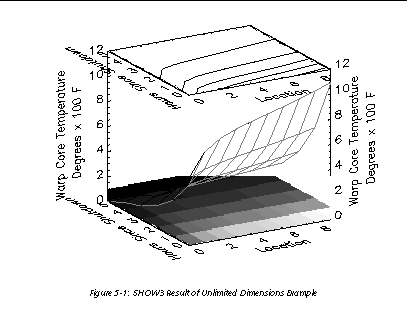 |
 |
The following IDL commands should be used to create a new netCDF file:
NCDF_CREATE: Call this procedure to begin creating a new file. The new file is put into define mode.
NCDF_DIMDEF: Create dimensions for the file.
NCDF_VARDEF: Define the variables to be used in the file.
NCDF_ATTPUT: Optionally, use attributes to describe the data.
NCDF_CONTROL, /ENDEF: Call NCDF_CONTROL and set the ENDEF keyword to leave define mode and enter data mode.
NCDF_VARPUT: Write the appropriate data to the netCDF file.
The following commands should be used to read data from a netCDF file:
NCDF_OPEN: Open an existing netCDF file.
NCDF_INQUIRE: Call this function to find the format of the netCDF file.
NCDF_DIMINQ: Retrieve the names and sizes of dimensions in the file.
NCDF_VARINQ: Retrieve the names, types, and sizes of variables in the file.
NCDF_ATTNAME: Optionally, retrieve attribute names.
NCDF_ATTINQ: Optionally, retrieve the types and lengths of attributes.
NCDF_ATTGET: Optionally, retrieve the attributes.
NCDF_VARGET: Read the data from the variables.
If the structure of the netCDF file is already known, the inquiry routines do not need to be called--only NCDF_OPEN, NCDF_ATTGET, NCDF_VARGET, and NCDF_CLOSE would be needed.
Two example files that demonstrate the use of the netCDF routines can be found in the hdf_ncdf subdirectory of the examples subdirectory of the IDL distribution. The file nncdf_cat.pro prints a summary of basic information about a netCDF file. The file ncdf_rdwr.pro creates a new netCDF file and then reads the information back from that file.
The following example shows how to create a netCDF file, populate it with data, read data from the file, and make a simple plot from the data.The resulting graphic is shown in SHOW3 Result of Unlimited Dimensions Example .

id = NCDF_CREATE('inquire.nc', /CLOBBER)
;
Create a new NetCDF file with the filename inquire.nc.
NCDF_CONTROL, id, /FILL ; Fill the file with default values.
hours = INDGEN(5) ; We'll create some time-dependant data, so here is an array of hours from 0 to 5.
data = FLTARR(5,10) ; Create a 5 by 10 array to hold floating-point data.
FOR i=0,9 DO $ ; Generate some values.
data(*,i) = (i+0.5) * EXP(-hours/2.) / SIN((i+1)/30.*!PI)
xid = NCDF_DIMDEF(id, 'x', 10) ; Make dimensions.
zid = NCDF_DIMDEF(id, 'z', /UNLIMITED)
hid = NCDF_VARDEF(id, 'Hour', [zid], /SHORT)
;
Define variables.
vid = NCDF_VARDEF(id, 'Temperature', [xid,zid], /FLOAT)
;
Define variable.
NCDF_ATTPUT, id, vid, 'units', 'Degrees x 100 F'
NCDF_ATTPUT, id, vid, 'long_name', 'Warp Core Temperature'
NCDF_ATTPUT, id, hid, 'long_name', 'Hours Since Shutdown'
NCDF_ATTPUT, id, /GLOBAL, 'Title', 'Really important data'
NCDF_CONTROL, id, /ENDEF ; Put file in data mode.
NCDF_VARPUT, id, hid, hours ; Input data.
FOR i=0,4 DO NCDF_VARPUT, id, vid, $
REFORM(data(i,*)), OFFSET=[0,i]; Oops! We forgot the 6th hour! This is not a problem, however, as you can dynamically expand a netCDF file if the unlimited dimension is used.
NCDF_VARPUT, id, hid, 6, OFFSET=[5] ; Add the hour and data.
NCDF_VARPUT, id, vid, FINDGEN(10)*EXP(-6./2), OFFSET=[0,5]
;
Add the temperature.
NCDF_VARGET, id, vid, output_data ; Read the data back out.
NCDF_ATTGET, id, vid, 'long_name', ztitle
NCDF_ATTGET, id, hid, 'long_name', ytitle
NCDF_ATTGET, id, vid, 'units', subtitle
!Y.TITLE = STRING(ytitle) ; Convert from bytes to strings.
!Z.TITLE = STRING(ztitle) + '!C' + STRING(subtitle)